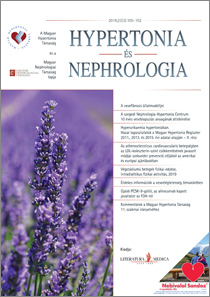The eLitMed.hu medical portal uses computer cookies for convenient operation. Detailed information can be found in the Cookie-policy.
Hypertension and nephrology - 2019;23(03)
Content
[Experimental models of renal fibrosis]
[The high incidence of chronic kidney diseases and, regardless of the etiology, their progression to renal fibrosis with end-stage renal failure rise the urgent need to reveal the pathomechanisms. As the disease leads to complex changes in the body, it is essential to use in vivo model systems for these investigations. Animal experiments choosing the appropriate model system helps to develop more sensitive early diagnostic markers and new therapeutic approaches. Several animal experimental model descriptions can be found in the literature, which mimic specific or more general human diseases in order to help the better understanding of the pathomechanisms. Using these model systems, we are able to analyze the detailed pathophysiology of glomerulonephritis, tubulointerstitial fibrosis, glomerular scarring or generalized renal fibrosis. The most commonly used model systems for renal fibrosis are presented and discussed.]
[Overview of a 10 years kidney biopsies data from the Nephrological and Blood Pressure Center Szeged]
[The authors retrospectively analyzed the data of kidney biopsies performed between 01/01/2007 and 31/12/2016 performed in the Center. During this period 452 biosies were performed. Mean age of patients was 48.7±15.0 years, of them, 43.5% were man and 56.5% women. The nephrotic syndrome was the most common (38.8%) clinical indications for a biopsy. The mos common histological diagnoses were the membranous nephropathy (16.7%), the IgA nephropathy (11.6%) and the FSGS (10.9%). The most common suggestions by nephrologists were the FSGS (17.4%), the membranous nephropathy (16.1%) and the IgA nephropathy (10.3%). These percentages of diabetic nephropathy were 7.5% and 12.2%. Minor complications not requiring any interventions occured in 98 cases (21.7%), major ones in 13 cases (2.9%). By the results FSGS seems to be overrated by nephrologists, but it is among the 3 most common histological findings. Diabetic nephropathy is a similarly excessive clinical diagnosis, sithence the histologically confirmed diagnoses are only a little more than half of it. Regular meetings of pathologists and nephrologists about clinical suggestions and real histological diagnoses may help to improve the ratio of more accurate suggestions.]
[Hyperuricemia in hypertension. Domestic experience based on the data of the Hungarian Hypertonia Register 2011., 2013., 2015. Part II.]
[Asymptomatic hyperuricemia is frequent in hypertension and its prevalence is increasing. Authors studied the incidence of serum uric acid levels and its correlation with age, risk factors, anthropological, metabolic characteristics, blood pressure, blood pressure target, organ damage, age-related co-morbidity in 47,372 hypertensive patients (22,688 males, 24,694 women). In the second part of their analysis the prevalence of hyperuricemia was 13.8% in hypertensive men and 21.6% in women. The age, BMI, waist diameter, systolic and diastolic blood pressure and onset of hypertension, serum cholesterol, triglyceride, blood glucose and serum creatinine were slightly higher, but serum HDL cholesterol and eGFR were slightly lower in hyperuricemic hypertensive patients, independently of their gender. Among hypertension mediated organ damage ischemic and left ventricular hypertensive ECG alterations, mild chronic kidney disease and proteinuria, among hypertension associated diseases diabetes associated ischemic heart disease, chronic kidney disease associated diabetes and both ischemic and chronic kidney disease associated diabetes were significantly more frequent in hyperuricemic hypertensive patients.]
1.
Clinical Neuroscience
Is there any difference in mortality rates of atrial fibrillation detected before or after ischemic stroke?2.
Clinical Neuroscience
Factors influencing the level of stigma in Parkinson’s disease in western Turkey3.
Clinical Neuroscience
Neuropathic pain and mood disorders in earthquake survivors with peripheral nerve injuries4.
Journal of Nursing Theory and Practice
[Correlations of Sarcopenia, Frailty, Falls and Social Isolation – A Literature Review in the Light of Swedish Statistics]5.
Clinical Neuroscience
[Comparison of pain intensity measurements among patients with low-back pain]1.
Clinical Neuroscience Proceedings
[A Magyar Stroke Társaság XVIII. Kongresszusa és a Magyar Neuroszonológiai Társaság XV. Konferenciája. Absztraktfüzet]2.
3.
Journal of Nursing Theory and Practice
[A selection of the entries submitted to the literary contest "Honorable mission: the joys and challenges of our profession" ]4.
Journal of Nursing Theory and Practice
[End of Life and Palliative Care of Newborns in the Nursing Context]5.
Journal of Nursing Theory and Practice
[Aspects of Occupational Health Nursing for Incurable Patients ]


